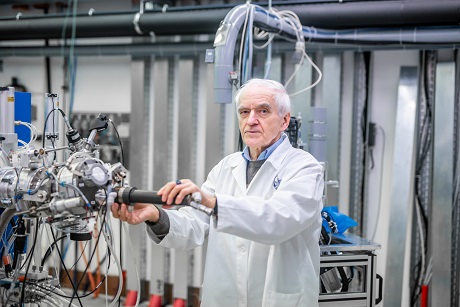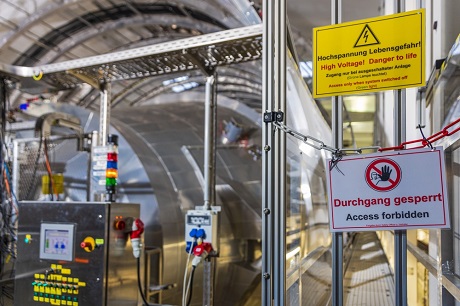
New record set for neutrino mass: one million times less than an electron
14. 04. 2025
It’s all around us, yet it evades conventional detection. The neutrino is an elementary particle – smaller than an atom, proton, or even electron. Its mass is so infinitesimal, in fact, that it can’t be precisely “weighed.” Instead, scientists determine its upper mass limit. Previously, this value stood at 0.8 electronvolts. The international KATRIN experiment has now demonstrated that the neutrino is even lighter: 0.45 electronvolts – approximately one million times less than the mass of an electron. A team of researchers from the Nuclear Physics Institute of the Czech Academy of Sciences played a pivotal role in this record measurement. The results were published in Science.
The neutrino is often dubbed mysterious, elusive, or even “the ghost” or “the poet” among elementary particles. Neutrinos are akin to “ninjas” among particles, silently and undetectably passing through everything around us – and even through us. Their existence was predicted in theory in 1930 by Austrian physicist Wolfgang Pauli, but the hypothesis wasn’t experimentally confirmed until twenty-six years later.
Like weighing a fly’s wing on a kitchen scale
Physicists have long endeavored to learn more about neutrinos, including, naturally, determining the mass of this elementary particle. However, it is so infinitesimal that the task is extraordinarily challenging. It’s comparable to trying to weigh a fly’s wing on a kitchen scale. Therefore, when discussing neutrinos, scientists refer to an “upper mass limit” rather than the mass itself.
“Neutrinos carry no electric charge and interact extremely weakly with surrounding particles. It could be said that weighing a neutrino is twenty thousand times more difficult than weighing the second-lightest particle, the electron. This factor of twenty thousand reflects the ratio between the cost of the apparatus built for the KATRIN experiment and the estimated cost of equipment for determining the electron’s mass,” explains Drahoslav Vénos from the Nuclear Physics Institute of the Czech Academy of Sciences (CAS).

Drahoslav Vénos from the Department of Heavy Ion Physics of the Nuclear Physics Institute of the CAS. (CC)
Sensitive scales
The most sensitive “scales” for neutrinos to date have been constructed by scientists involved in the international KATRIN project – the Karlsruhe Tritium Neutrino Experiment. The experimental setup in Karlsruhe, Germany, is enormous. It spans a total length of 70 meters, with the most crucial component – the world’s largest specialized electron spectrometer – measuring 23 meters in length, 10 meters in diameter, and weighing 200 tons.
In 2022, the KATRIN experiment successfully determined the upper mass limit of the neutrino at 0.8 electronvolts. Now in 2025, this limit has been further refined. To ascertain the mass, researchers monitored the beta decay of tritium – an unstable isotope of hydrogen. Czech scientists from the Nuclear Physics Institute of the CAS contributed significantly by developing a potent source of gaseous krypton that is essential for the measurements.
“Years of experience in radionuclide preparation, separation methods, and process automation enabled us to safely prepare a unique krypton source with the desired properties,” explains Ondřej Lebeda, Head of the Department of Radiopharmacy at the Nuclear Physics Institute of the CAS.
“We’re delighted with the results. Our many years of work on developing a calibration source of conversion electrons have found application in such a significant experiment as KATRIN, and thanks to this, key results for fundamental physics are emerging. It’s undoubtedly a good feeling,” Vénos adds.

The KATRIN experiment is located in Germany, with scientists from several countries, including the Czech Republic, contributing to it.
What’s the benefit?
Physicists have been endeavoring to determine the mass of neutrinos for decades. The first experimental attempts date back to 1948, when the upper limit was set at 5,000 electronvolts – approximately eleven thousand times higher than the current findings of the KATRIN experiment.
Refining the upper limit can invalidate certain theoretical calculations of neutrino mass and, consequently, the assumed properties of the particle. New data enhances the precision of existing theories and the cosmological model of the universe and may lead to a deeper understanding of the laws of nature.
The KATRIN project was initiated in 2001 by Germany, Russia, the USA, the UK, and the Czech Republic. The inclusion of Czech Republic among these major nations was due to the expertise of researchers from the Nuclear Physics Institute of the CAS in electron and gamma-ray spectroscopy, radiochemistry, and radionuclide preparation using accelerators.
Written and prepared by: Leona Matušková, External Relations Division, CAO of the CAS, drawing on the NPI press release
Translated by: Tereza Novická, External Relations Division, CAO of the CAS
Photo: Shutterstock; Jana Plavec, External Relations Division, CAO of the CAS
 The text and photos labeled CC are released for use under the Creative Commons license.
The text and photos labeled CC are released for use under the Creative Commons license.
Read also
- Renewables are a strategic investment in European security, scientists say
- On the trail of the endangered little owl: searching for newly hatched owlets
- Teen scientist breaks barriers: No child is a lost cause
- The Czech Academy of Sciences has appointed its new leadership for 2025–2029
- Literature is tied to its historical context. How can we read between the lines?
- Radomír Pánek: The Academy must be united, strong, and proactive
- A springtime booster: The healing potential of tree buds
- A novel compound that protects bone cells may benefit diabetic patients
- New interactive exhibition at the CAS showcases materials shaped by genius ideas
- Leaf growth, root formation, and reproduction – Look to hormones for the answer
Contacts for Media
Markéta Růžičková
Public Relations Manager
+420 777 970 812
Eliška Zvolánková
+420 739 535 007
Martina Spěváčková
+420 733 697 112